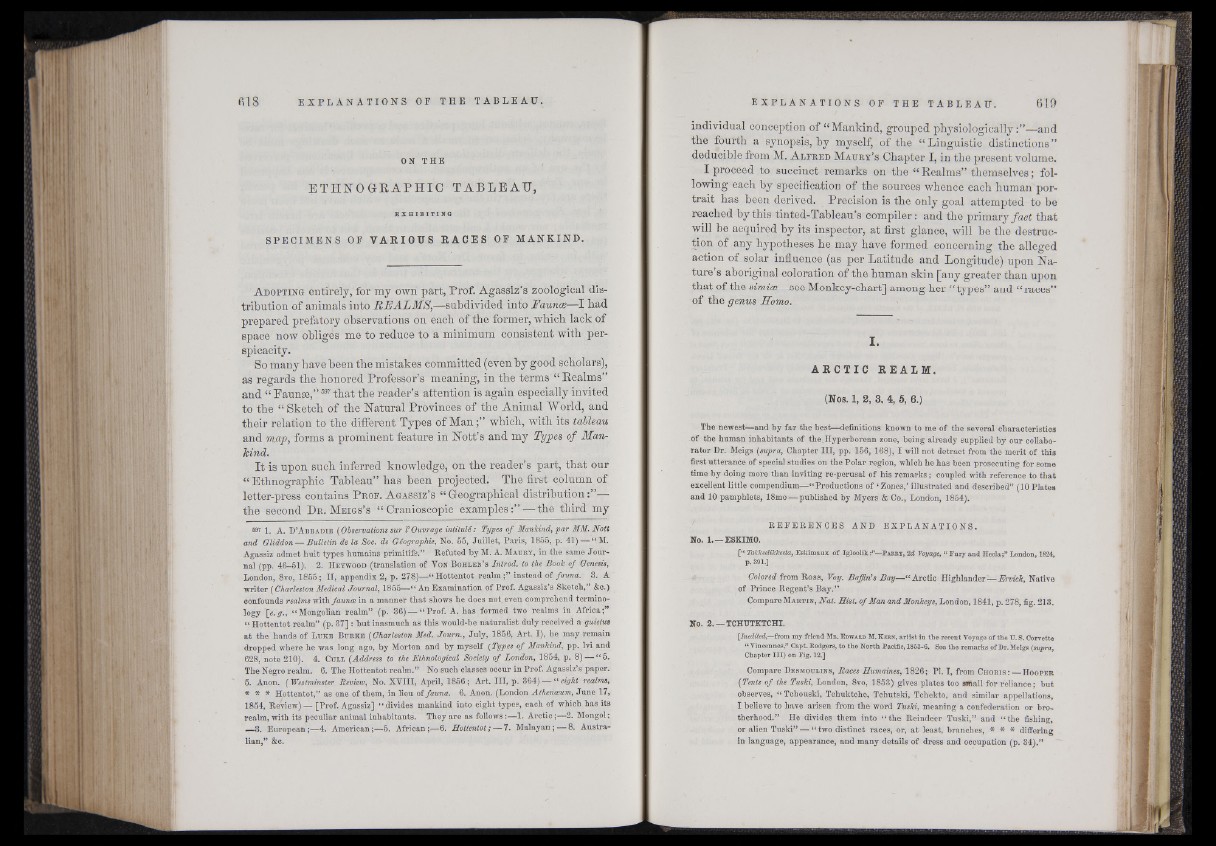
ON THE
E T H N O G R A P H IC T A B L E A U ,
E X H I B I T I N G
S P E C IM E N S OF VARIOUS RACES OF M A N K I N D .
A dopting entirely, for my own part, Prof. Agassiz’s zoological distribution
of animals into REALMS,—subdivided into Faunce—I bad
prepared prefatory observations on each of the former, wbicb lack of
space now obligés me to reduce to a minimum consistent with perspicacity.
So many have been the mistakes committed (even by good scholars),
as regards the honored Professor’s meaning, in the terms “ Realms”
and “ Eaunæ,” 697 that the reader’s attention is again especially invited
to the “ Sketch of the Raturai Provinces of the Animal World, and
their relation to the different Types of Man;” which, with its tableau
and map, forms a prominent feature in Rott’s and my Types of Man-
kind.
It is upon such inferred knowledge, on the reader’s part, that our
“ Ethnographic Tableau” has been projected. The first column of
letter-press contains P rof. A gassiz’s “Geographical distribution:”—
the second D r . M e ig s ’s “ Cranioscopic examples :” —the third my
691 1. A. D ’A b b a b ie (Observationssur VOuvrage intitulé: Types of Mankind,par MM. Nott
and Gliddon — Bulletin de la Soc. de Géographie, No. 55, Juillet, Paris, 1855, p. 41) —“M.
Agassiz admet huit types humains primitifs.” Refuted by M. A. M a u ry , in the same Journal
(pp. 46-51). 2. H e tw oo d (translation of V on B o h l e n ’s Introd. to the Book of Genesis,
London, 8vo, 1855; II, appendix 2, p. 278)—“ Hottentot realm;” instead of fauna. 3. A
writer (Charleston Medical Journal, 1855—“ An Examination of Prof. Agassiz s Sketch, &c.)
confounds realms with faunae in a manner that shows he does not, even comprehend terminology
[e.g., “ Mongolian realm” (p. 36)— “ Prof. A. has formed two realms in Africa;”
“ Hottentot realm” (p. 37] : hut inasmuch as this would-be naturalist duly received a quietus
at the hands of L u k e B u r k e (Charleston Med. Journ., July, 185.6, Art. I), he may remain
dropped where he was long ago, by Morton and by myself (Types of Mankind, pp. lvi and
628, note 210). 4. C u l l (Address to the Ethnological Society of London, 1854, p. 8) — “ 5 .
The Negro realm. 6. The Hottentot realm.” No such classes occur in Prof. Agassiz’s paper.
5. Anon. (Westminster Review, No. XVIII, April, 1856; Art. I ll, p. 864) — ‘1 eight realms,
* * * Hottentot,” as one of them, in lieu of fauna. 6. Anon. (London Athenoeum, June 17,
1 8 5 4 , Review)— [Prof. Agassiz] “ .divides mankind into eight types, each of which has its
realm, with its peculiar animal inhabitants. They are as follows :—1. Arctic f—2. Mongol ;
.—3. European;—4. American;—5. African;—6. Hottentot; — 7. Malayan;-—8. Australian,”
&c.
E X P L A N A T I O N S OF T H E T A B L E A U . 6 1 9
individual conception of “ Mankind, grouped physiologically —and
the fourth a synopsis, by myself, of the “ Linguistic distinctions”
deducible from M. A lfred M a u r y ’s Chapter I, in the present volume.
I proceed to succinct remarks on the “ Realms” themselves; following
each by specification of the sources whence each human portrait
has been derived. Precision is the only goal attempted to be
reached by this tinted-Tableau’s compiler: and the primary fact that
will be acquired by its inspector, at first glance, will be the destruction
of any hypotheses he may have formed concerning the alleged
action of solar influence (as per Latitude and Longitude) upon Ra-
ture’s aboriginal coloration of the human skin [any greater than upon
that of the simice—see Monkey-chart] among her “types” and “ races”
of the genus Homo.
ARC TI C R E A IM.
(Nos. 1, 2, 3. 4, 5, 6.)
The newest—and by far the best—definitions known to me of the several characteristics
of the human inhabitants of the.Hyperborean zone, being already supplied by our collaborator
Dr. Meigs (supra, Chapter III, pp. 156, 168), I will not detract from the merit of this
first utterance of special studies on the Polar region, which he has been prosecuting for some
time by doing more than inviting re-perusal of his remarks ; coupled with reference to that
excellent little compendium— “Productions of ‘Zones,’ illustrated and described” (10 Plates
and 10 pamphlets, 18mo—published by Myers & Co., London, 1854).
REFERENCES AND EXPLANATIONS.
No. 1. —ESKIMO.
[“tPakkeetikkeeta, Eskimaux of Igloolik:”—Pittar, 2d Voyage, ‘‘Fury and Hecla;” London, 1824,
p. 391.]
Colored from Ross, Voy. Baffin's Bay—“ Arctic Highlander— .Errò*, Native
of Prince Regent’s Bay.”
Compare Maktin, Nat. Hist, of Man and Monkeys, London, 1841, p. 278, fig. 213.
No. 2. — TCHUTKTCHI.
[Inedited,— from my friend Mr. E d w a r d M. K e r n , artist in the recent Voyage of the IT. S. Corvette
« Vincennes,” Capt. Rodgers, to the North Pacific, 1863-6. See the remarks of Dr. Meigs (supra,
Chapter III) on Fig. 12.]
Compare Desmoulins, Races Humaines, 1826; PI. I, from Chohis Hooper
(Tents of the Tuski, London, 8vo, 1853) gives plates too Mflnljl for reliance; but
observes, “ Tchouski, Tchuktche, Tchutski, Tehekto, and similar appellations,
I believe to have arisen from the word Tuski, meaning a confederation or brotherhood.”
He divides them into “ the Reindeer Tuski,” and “ the fishing,
or alien Tuski” — “ two distinct races, or, at least, branches, * * * differing
in language, appearance, and many details of dress and occupation (p. 34).”